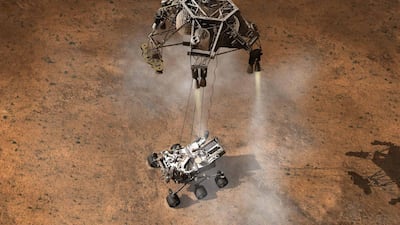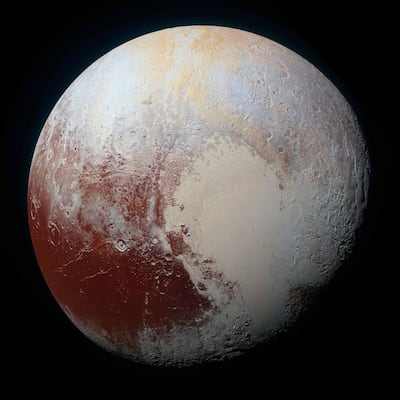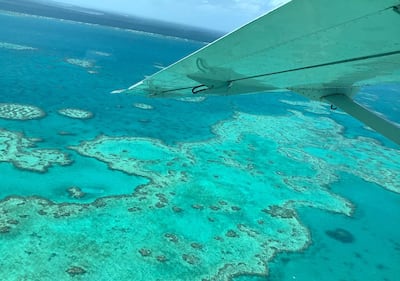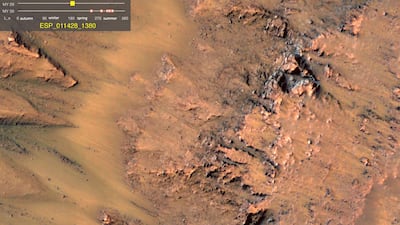Ramadan 2020, in the Islamic year 1441, will always be remembered for one thing: Covid-19. But momentous events have always occurred during the holy month down the years.
As part of a series delving into Ramadan over recent decades, starting in 1950, we look back over the last 70 years at some of the headlines from previous Ramadans, with an emphasis on the positive, of news that shows the strength and creativity of the human spirit.
2011 (1432) July 31 – August 29
Is there life on Mars? That was the question posed by Nasa's Mars Reconnaissance Orbiter as it circled the Red Planet at the start of the decade.
Launched in August 2005, the unmanned craft observed the planet’s slopes and crater walls during the Martian seasons.
It found creeping dark fingers on the landscape that extended during the spring and summer but faded as winter approached.
Water had been discovered on Mars in previous missions but as ice at the northern polar cap. The planet’s low temperature meant that any surface water would be permanently frozen.
On August 4, 2011, an announcement from Nasa suggested another possibility, that evidence of flowing water had been discovered for the first time.
Scientists theorised the water was below the surface and flowed during the warmer months, even though these also have temperatures well below freezing.
To remain liquid, it would have to be extremely salty – “more like a syrup,” according to one expert.
The presence of flowing water greatly increased the possibility of life on Mars or the possibility it could sustain it.
The orbiter continues to circle Mars, relaying data from other craft on the planet’s surface.
It is now one of six operating space craft circling Mars, and will be joined next year by the UAE's Hope mission, which will further expand our knowledge of the planet's weather and atmosphere.

2012 (1433) July 19 to August 18
We remember the summer Ramadan for the London Olympics, which took place between July 27 and August 12.
During that time, Turkish adventurer Erden Eruç completed his own personal race and became the first person to circle the Earth using only human power, including bicycles and boats. Finishing on July 21, it took him just over five years.
This Ramadan was also notable for "seven minutes of terror." That was the dramatic title given to an attempt to put the Curiosity lander on the surface of Mars.
An audacious and untested technique was proposed, which involved suspending the lander under a “sky crane” that would slow the final descent using rocket thrusters.
At the last minute, the sky crane would detach and fly away to prevent damage to Curiosity, the final act of a complex series of manoeuvres, any one of which could end the $2.5 billion mission.
The “seven minutes of terror” referred to the time between entering Mar’s atmosphere and the final touchdown. The time lag in communications to Earth meant that scientists would not know if the mission had succeeded for nearly a quarter of an hour.
In the end, all was well. Curiosity landed on August 5, 2012 and remains operational.
It will be joined next year by Perseverance, another rover that will land using the same technique, in the best Hollywood tradition as "Seven Minutes of Terror 2."

2015 (1436) June 17 – July 16
The space theme of Ramadan during the past 10 years continued with an achievement from the New Horizon deep space probe.
Launched in 2005, the craft finally reached its destination on July 14, 2012, when it completed a fly-by of Pluto at an altitude of 12,442 kilometres and a distance of around four billion miles from Earth.
It took until October 2016 for New Horizon to send back all the data it gathered and the result was our first glimpse of the distant dwarf planet and a series of spectacular images of Pluto and its mysterious five satellite moons.

2018 (1439) May 16 – June 14
We remember the Ramadan of 2018 for two events that were celebrated at the time but perhaps did not end as expected.
The first was the wedding, on May 19, of Prince Harry and Meghan Markle at St George’s Chapel in Windsor Castle.
The marriage of a prince of the British Royal family to an African-American actress attracted huge international attention, with a live audience of 27 million in the UK and 29 million in the United States.
The ceremony was notable for the presence of numerous celebrity friends of the couple and a 14-minute sermon by bishop Michael Curry described as “electrifying.”
What was hailed at the time as landmark for race relations ended with the couple and their son withdrawing from royal life to self imposed exile in California, the result of what they said is intrusion into their private lives.

Later that month, the world watched open-mouthed again as the President of the United States, Donald Trump, shook the hands of his country’s sworn enemy, Kim Jong-un, the leader of North Korea.
The historic meeting took place in Singapore on June 12, with a statement agreeing to new peaceful relations and an end to nuclear weapons on the Korean peninsula.
The summit was followed last year by a meeting between the two leaders on the border of North and South Korea that made President Trump the first American president to step on North Korean soil.
It is fair to say the progress since has been limited at best. Negotiations last took place in October, with North Korea warning of “terrible” events if it did not get a better deal, and the US posting a $5 million reward for North Korean hackers it claimed were launching cyber attacks.

2020 (1441) began April 23
This year's Ramadan will certainly be remembered throughout history, with Covid-19 forcing families to stay home with tens of thousands dead and millions infected.
Despite the global crisis, progress has been made against another disease, malaria, which claims about 400,000 lives and is estimated to cost African economies $12 billion every year.
On May 4, it was announced that scientists in Kenya and the UK had discovered a microbe that completely prevents mosquitoes that spread malaria from contracting the disease in first place.
The bug, Microsporidia MB, was found in mosquitoes on the shores of Lake Victoria, none of whom harboured the malarial parasite.
At present around five per cent of mosquitoes have Microsporidia MB but deliberately raising this to 40 per cent, possible through infecting males in laboratories, could hugely reduce malaria in humans.
A development was also made in the fight against climate change – specifically the bleaching of coral reefs, which is caused by excess carbon dioxide warming oceans.
On May 13, scientists in Australia working on the Great Barrier Reef revealed they had cloned algae in a laboratory that can live in warmer seas.
Algae have a complex relationship with coral. They live inside coral polyps and nourish their host by photosynthesising waste into food.
When the water becomes too warm, corals expel algae, a process that turns the coral white but also leaves it to starve.
Breeding these algae and releasing them into the wild holds out the possibility of slowing the decline in coral reefs worldwide and a happier legacy of this Ramadan.


